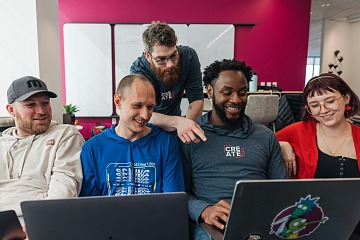Here's how you should focus efforts to recruit and support veterans and current service members and their families.
Military veterans, reservists, and members of the National Guard can be valuable additions to your workforce, bringing their can-do spirit and specialized training to a variety of civilian roles.
Every year, more than 200,000 service members transition out of the armed forces. Companies that can offer them a great employee experience are poised to capture talented, hardworking employees looking to start their next chapter.
How to support veterans in 2023
Here are some tips from great workplaces on how to help veterans thrive within your organization:
1. Celebrate their service
Military vets are proud of their service and believe that experience has set them up well for careers in the civilian world, according to a report from Navy Federal Credit Union.
“Companies should encourage veterans to draw on that experience and unique skill set in their civilian careers,” says Clay Stackhouse, a retired Marine Corps colonel and regional outreach manager at Navy Federal Credit Union. “This kind of environment not only helps ease the transition to civilian life for veterans, but helps ensure greater productivity and employee retention.”
Attend our annual company culture conference May 7-9, 2024
Great companies find ways to help veterans and current service members share their stories.
Bell Bank creates videos sharing stories of employees like Andrew Gaydos, a Bell employee and Army captain who deployed as part of a civil affairs team to Romania in 2014.
Gaydos was away from his job at Bell and his family for about a year, during which time his co-workers jumped in to help his family by bringing meals and even helping with some chores on their hobby farm outside Fargo, North Dakota.
“Bell was very supportive of my military service,” says Gaydos. “Our national defense is dependent on having employers that support the Reserve and National Guard.”
Bell’s efforts to care for service members have been recognized by the Department of Defense, including an award for manager Brittany Lang and her team for their support of a Bell military family in 2023.
Bell Bank also honors its veterans each year in a video on Veteran’s Day shared with all its associates across the company.
“I believe you need to connect with people’s hearts,” says Julie Peterson Klein, chief of staff and chief culture officer for Bell Bank. “Once you connect with their heart, then they want to be employed at our great company.”
2. Help them navigate the hiring process
At Bell Bank, service members are always brought in for a screening interview, even if there isn’t a job opening for them yet.
“From day one when I arrived, it was very important to me that if we have a resume that comes in and they have served our country, that they get automatically brought in for a screening interview because it’s very important to me to support our veterans,” Klein says.
“That is one thing that we’ve done for my entire career here. If you have served or are serving, we want to meet you and get to know you.”
3. Offer financial education tools
Data from Navy Federal Credit Union’s “Best Careers After Service” report shows that the average service member has saved over $9,000 upon leaving the service, but feel like they could use more information about retirement saving and investing.
“Companies seeking to create a welcoming environment for veterans should consider this as they develop employee development and benefits programs,” Stackhouse says.
In this way veterans resemble lots of other employees in today’s workplace who are looking for financial well-being and resources to build a strong foundation for their families.
4. Prioritize flexibility
Workplace flexibility has become increasingly important for all workers in the post-pandemic era. Veterans are no exception.
“Like many others, veterans place an increased emphasis on flexibility,” Stackhouse says. “Among veterans who say their idea of the ideal job has changed within the past three to four years, the most common shifts were in their work environment (26%) and career fields (17%).”
5. Develop employee resource groups for vets
Employee resource groups (ERGs) are valuable tools for many employees, but particularly for veterans who value advice from other former service members as they navigate their transition out of the military.
“According to our Best Careers After Service report, less than half of veterans feel that they were highly prepared for transition to civilian life,” Stackhouse says. “For career advice, family, friends, and fellow veterans were the most commonly relied upon sources.”
It can also be helpful to work with nonprofit groups and organizations that focus on helping veterans build a career after their service. “More specialized resources can provide tailored career coaching to help smooth the transition,” Stackhouse says.
6. Connect employees to a higher purpose
Meaningful work is highly prized by all employees, but for veterans, the ability to continue their service is especially compelling.
Other than compensation, serving a purpose is the most sought after trait in a career, underscoring veterans’ desire to continue serving their communities, even after leaving the military, according to the report from Navy Federal.
“They’ve learned followership and then leadership in the military, but it’s all about being on a team and working together. A team with a noble goal is empowering to veterans,” Stackhouse says.
7. Help them build a career
Service members transitioning to the civilian workforce are used to being part of a big, mission-driven team.
“Employers should also recognize that there are multiple paths to success for servicemembers transitioning out of the military, including vocational education and other career training,” says Stackhouse. “Offering veterans opportunities for instruction in skilled trades, upskilling, and other career development will help establish stable, meaningful career pathways for servicemembers transitioning out of the military.”
“In short, it’s about building a fulfilling career,” he says.
Get more insights
Learn more strategies from our workplace culture experts at our For All™ Summit, May 7-9 in New Orleans.













